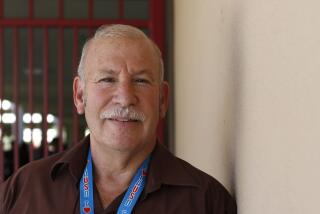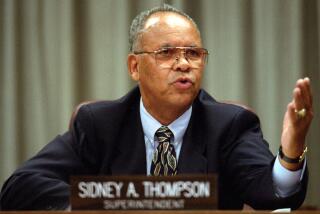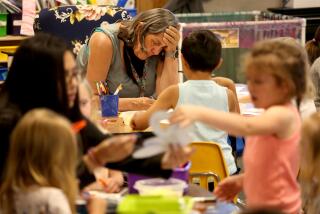VENTURA : School District’s History Recorded
- Share via
Six years ago, Patrick Rooney set out to write a book that he knew most people wouldn’t read.
Rooney, who spent 21 years as superintendent of the Ventura Unified School District, decided to chronicle the district’s history as part of an early retirement program.
Now, 499 single-spaced pages and 300,000 words later, Rooney’s book is finished. More than 75 copies will be distributed throughout the district’s libraries.
“It doesn’t read like ‘Gone With the Wind,’ of course, but it’s all there,” said the 66-year-old Rooney, taking a break Monday from correcting papers for the summer school course that he is teaching at the University of Southern California.
Titled “A History of the Ventura Unified School District 1962-1986,” the book discusses the toughest issues the district faced during Rooney’s tenure and the three years before he arrived.
“I felt that there was a tremendous amount of information that otherwise would be . . . maybe forgotten or lost,” the Ventura resident said.
Rooney spent four years compiling all the appropriate materials, from newspaper clippings to minutes of meetings, and then took six months to get it down on paper.
“I tried to be careful, to not let it be an aggrandizement of me,” he said.
Rooney said the district’s most dramatic change occurred when it chose to merge with five other districts and part of another. The 1965 unification melded 29 schools into one 14,778-student district, he said. As of April, Ventura Unified had grown to 15,436 students.
For Rooney, the challenge of unification came in “bringing the six districts together from rather diverse backgrounds and with . . . strong feelings and the traditions that people accepted and revered.”
The book, written chronologically, also talks about the desegregation of all district schools in 1970, another highlight of Rooney’s tenure.
“We desegregated schools voluntarily,” he said. “We just felt that it was the best for the education of students to have a desegregation system that meant busing, matching and pairing schools. That was a trauma in the community.”
The next important milestone for Rooney was the reorganization of the schools in 1980 to allow for middle schools, which gear curriculum to the adolescent student and group sixth-grade students with seventh- and eighth-graders.
“The major complaint came from parents,” he said. “They did not relish the idea of sixth-graders going to a middle school and leaving the elementary school. They felt that the environment was a little too sophisticated for them. But now we’ve had it for 10 or 11 years. When people don’t know anything else, then they accept it without any complaints.”
More to Read
Sign up for Essential California
The most important California stories and recommendations in your inbox every morning.
You may occasionally receive promotional content from the Los Angeles Times.













